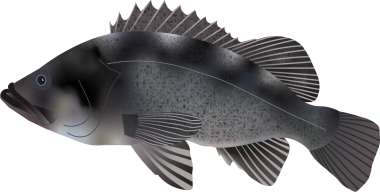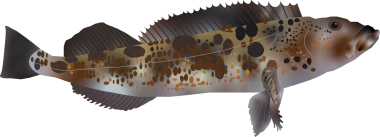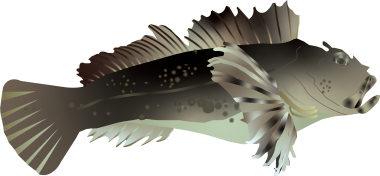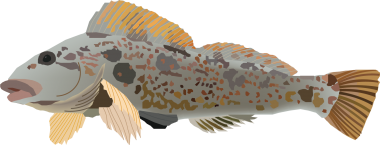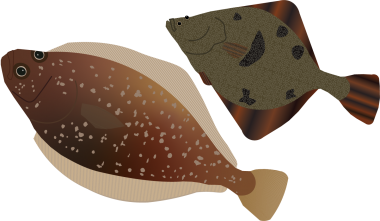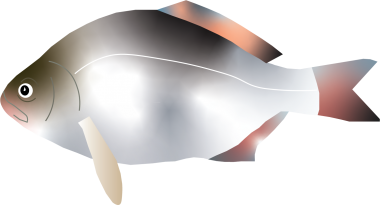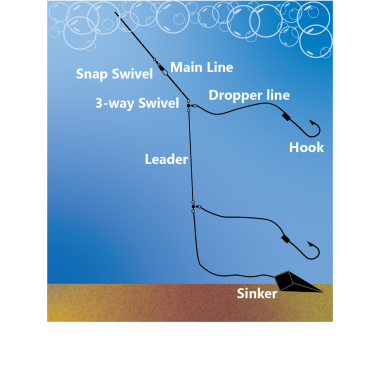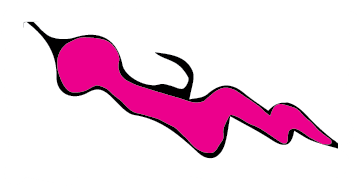
Regulations
Lingcod (a.k.a. ling)
Fish fact: Lingcod are about 1 foot long by their first birthday and about 3 feet long when 10 to 12 years old. Lingcod have large mouths and large, sharp teeth. They are generally mottled gray or brown, sometimes with green or blue. A green-colored “ling” should not be confused with a greenling. Lingcod may reach lengths of 5 feet, although those caught in Oregon average between 2 to 3 feet.
Technique: Bounce some bait along the bottom with 5/0 or 6/0 hooks, a 4- to 6-ounce sinker, and 20-pound line on a stout rod.
Cabezon (a.k.a. bullhead)
This is a red, brown, or green mottled member of the sculpin family with smooth, scaleless skin. Deemed ugly by some, cabezon are nonetheless very tasty. However, avoid eating the eggs and liver since they are poisonous to humans. Cabezon can grow to over 2 feet.
Fish fact: Like lingcod and greenling, the male cabezon guards the nest after the female deposits the eggs.
Technique: Use the bottomfish fish-finder rig. Cabezon live around kelp beds and rocky headlands over hard bottoms.
Greenling (a.k.a. sea trout)
Female kelp greenling are light gray or brown with orange speckling and yellow fins, while males are brown with blue spots and black fins. Rock greenling are dark brown (often with red spots) with a blue mouth. Both species can grow to about 2 feet.
Fish fact: Most fishes have just one lateral line along each side of their body to detect movement, but kelp and rock greenlings have five.
Technique: These fish have small mouths, so try a #4 to #6 hook to catch these daytime feeders.
Flatfish (a.k.a. soles, flounders, and sanddabs)
Flatfish are dark on the upper side, lighter underneath and, as one might guess, they are flat. Shore anglers can catch sand sole and English sole over sandy bottoms near the mouth of bays and starry flounder in estuaries. Many flatfish reach lengths of 1 to 2 feet.
Fish fact: Flatfish begin life with one eye on each side of the head and they swim upright in the water, like other fish. Later, they settle to the bottom onto one side. The eye on the bottom gradually migrates to the upper side.
Technique: Try a small jig or bait (such as shrimp, marine worm, or mussel) with #2 hooks, a 2-ounce sinker, and 10- to 15-pound line over sandy or muddy bottom.
Safety
• Be sure of your footing and the stability of rocks when fishing from jetties.
• Watch for larger-than-usual (sneaker) waves when fishing from beaches or rocks.
• Stay clear of large logs in or near the surf. Every year in Oregon people are killed by logs.
• Don’t let your chest waders fill with water when surf fishing.
OTHER MARINE FISHES
Herring, anchovy and sardine
These typically blue-green and silvery fish are an important food source for larger fishes, sea birds and marine mammals. People also enjoy such treats as anchovy pizza, pickled herring and herring roe. Anchovies may grow to 9 inches and herring to 18 inches.
Fish fact: Pacific herring otoliths (ear bones) have been found in deposits more than 3 million years old.
Techniques: These are schooling fish, commonly caught during spawning seasons. Pacific herring, northern anchovy and sardine are caught in bays with multiple-hook herring jigs.
Litter
Surfperch
Surfperch are disc-shaped and come in a variety of colors. Redtail surfperch and silver surfperch are found mostly in the surf. Striped seaperch, pile perch, white seaperch and shiner surfperch all live near rocks, docks or pilings in bays. “Shiners” are full-size at 5 inches, other species at 12 to 18 inches.
Fish fact: Surfperch live in large schools and bear live young up to 2 inches long.
Techniques: Some anglers use a #4 to #6 hook secured 24 to 30 inches below a 1- to 2-ounce sinker on 8- to 10-pound line. Other anglers use a bottomfish fish-finder rig. Baits can be real or artificial, and include sand and kelp worms, sand shrimp, clam necks and mussels. Keep the line close to rocks or alongside pilings, places favored by surfperch. Fishing for “redtails” in the surf requires a surfperch surf-fishing rig (see below).
Tagged fish
ANADROMOUS FISHES
Anadromous fishes are those that migrate from the ocean into freshwater to spawn.
Salmon
Salmon anglers should know how to distinguish between a Chinook (king) and a coho (silver) salmon. Steelhead and sea-run cutthroat trout are also occasionally taken in saltwater.
Fish fact: Pacific salmon such as Chinook and coho die after spawning, but steelhead and sea-run trout can live to spawn again another year.
Technique: Shore anglers use spinners or bait in autumn. Chinook are usually caught with larger plugs, herring, spoons, spinners, or metal jigs and coho are primarily targeted using spinners and spoons inside the estuaries.
Conservation
Sturgeon
Both green sturgeon and white sturgeon are found in Oregon. In most areas, retention of sturgeon is not allowed, but anglers can try their hand at catch-and-release. Historical records list one white sturgeon tipping the scales at 1,500 pounds and measuring 20 feet. Those caught in Oregon, however, usually measure less than 12 feet.
Fish fact: Sturgeon may live to be over 100 years old and spawn only once every 2 to 8 years.
Technique: Both boat and shore anglers use shrimp, smelt or herring with a single 6/0 or 7/0 barbless hook, a 2- to 8-ounce sliding sinker, and 30- to 40-pound line. Sturgeon dwell on the bottom of deep holes in upper bays. When handling a sturgeon, be careful for the sharp scutes (bony plates) along the sides. Release the fish immediately if retention is not allowed.
Which fish live where?
BAYS AND ESTUARIES
Shore anglers have access to a variety of fishes living in bays, estuaries, and tidal waters. Rocks and jetties are the best places to fish year-round for bottomfish such as rockfish, lingcod, greenling and cabezon. Many species of surfperch live around rocks, docks, and pilings year-round. Herring are jigged from docks and piers in the winter. Sturgeon can be found in channels and deep holes of upper bays and estuaries in the winter and spring. Salmon pass through bays and estuaries on their way to spawn in freshwater in the summer or fall.
OCEAN BEACHES
Most anglers on the beach target redtail surfperch, primarily during the spring and summer months. However, the fish are present year-round and available to hardy winter anglers.
What rigs work?
Different rigs and baits may work better at particular places and times of year. You can ask at a coastal bait or tackle shop for local up-to-date fishing information.
BOTTOMFISH FISH-FINDER RIG
Main line: Use 15- to 20-pound line from jetties and rocks
Leader and dropper lines: These should be 2 to 4 pounds lighter than the main line and attached with 3-way swivels
Hooks: #1 to #6 snelled baitholder hooks
Sinker: ½- to 6-ounce depending on the current
Bait: Sand/ghost shrimp, pile worms, herring or squid
Snap Swivel: Optional; for the ability to easily change gear.
How to use:
- Let the rig sink to the bottom.
- Raise your rod about 12 inches, reel in the slack line, then allow the rig to sink again.
- Repeat until you have a bite. Make sure to periodically check your bait.
A variation, in place of a sinker and snelled baitholders, is to use a ¼- to 1-ounce leadhead jig with a rubber worm or rubber minnow. Drop it to the bottom then slowly retrieve.
REDTAIL SURFPERCH SURF-FISHING RIG
Main line: Use 10- to 20-pound line
Leaders: 24 inches
Dropper lines: 8 to 12 inches, attached with 3-way swivels
Hooks: #2 to #4 snelled bait holder hooks
Sinker: 1- to 6-ounce pyramid or long tailed Sputnik sinker
Bait: Sand or kelp worms, sand shrimp, clam necks or mussels. Some anglers attach a piece of colorful yarn to each hook.
Snap Swivel: Optional; for the ability to easily change gear
Tips:
- Look for places where the beach drops off steeply or where freshwater enters the ocean.
- The best fishing is in spring and summer.
- At high tide, redtail surfperch are closer to shore so you will not need to cast far.
Marine shore fishing access maps
There are marine fishing opportunities from the Columbia River to the California border. These access maps list fishing piers, surfperch beaches and other fishing locations for the north, central and south coasts.
North coast marine fishing access
Central coast marine fishing access
South coast marine fishing access
For further information:
Visit MyODFW.com. There you will find information about recreational fish and shellfish opportunities. You may also contact the ODFW Marine Resources Program by phone at (541) 867-4741 or in person. Consult your local library or bookstore for fish identification guides and books on marine fishing. For more information about boating, visit the Oregon Marine Board online at Oregon.gov/OSMB or call them at (503) 378-8587.
References:
Eschmeyer, W. N., E. S. Herald, H. Hamman. Pacific Coast Fishes. Houghton Mifflin Company, Boston, 1983.
Field Guide to Common Marine and Bay Fishes of Oregon. Oregon State University Extension Service, 1984.
Love, R. M. Probably More Than You Want to Know About the Fishes of the Pacific Coast. Really Big Press, Santa Barbara, 1991.
Olander, D. Northwest Coastal Fishing Guide. Frank Amato Publications, Portland, 1991.

